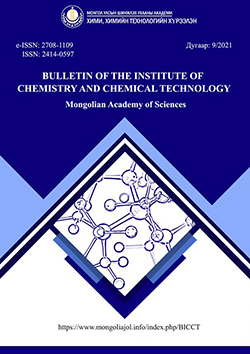Synthetic fatty acids from solid paraffin of Tsagaan-Els oil deposit
DOI:
https://doi.org/10.5564/bicct.v4i9.1813Keywords:
synthetic fatty acid, paraffin, crude oil, catalyst, oxidate, mathematical modelingAbstract
In this work, fatty acids, the raw materials for detergents, were obtained by the oxidation reaction of solid paraffin
extracted from the Tsagaan-Els petroleum deposit of Mongolia. The oil fraction distilled from the crude oil at 350-450°C was 20.06 mass %, and the solid paraffin was extracted from the oil fraction by complexation with urea with a yield of 34.28 %. Extracted solid paraffin contained hydrocarbons of C17-C34 and was unimodal in molecular mass distribution. Optimal conditions for the oxidation reaction of solid paraffin extracted from the oil fraction were determined by mathematical modeling depending on various reaction parameters and found to be 0.6 l/min for catalyst amount and 0.1 mass % (from paraffin) for oxygen flow. The oxidation reaction of solid paraffin extracted from the Tsagaan-Els petroleum deposit resulted in a fraction of synthetic fatty acid with a yield of 44.09
mass %. Infrared spectroscopic analysis of the synthetic fatty acids revealed that oxygen-containing compounds formed from the reaction were predominantly monocarboxylic acids and GC-MS studies have shown that these fatty acids are synthetic fatty acids containing carbon atoms of C7-C26. We report that it is possible to oxidize the solid paraffin of petroleum in our country to produce synthetic fatty acids, which are widely used in detergent production.
Цагаан-Элсний ордын нефтийн хатуу парафинаас нийлэг тосны хүчил гарган авах
Хураангуй: Энэхүү ажлын хүрээнд Монгол орны Цагаан-Элсний ордын нефтийн хатуу парафиныг исэлдүүлэн
гадаргуугийн идэвхт үйлчлэлтэй угаагч бодисын гол түүхий эд болох нийлэг тосны хүчил гарган авах судалгааг явуулсан. Судлагдаж буй нефтийн 350-450°C-д нэрэгдэх тосны фракц нь 20.06 мас.% -ийг эзлэх бөгөөд тосны фракциас карбамидаар комплекс үүсгэх замаар хатуу парафиныг 34.28 хувийн гарцтайгаар ялган авав. Хатуу парафин нь найрлагандаа С17–С34 бүхий нүүрстөрөгчийн атом агуулсан, молекул массын тархалтаараа унимодаль шинжтэй байв. Нефтийн тосны фракцаас ялгасан н-парафиныг молекул хүчилтөрөгчөөр исэлдүүлэх процессын зохимжтой горимыг янз бүрийн параметрүүдээс
хамааруулан математик загварчлалын аргаар тооцоолоход катализаторын хэмжээ 0.1 мас.% (парафинд тооцсоноор), хүчилтөрөгчийн урсгалыг 0.6 л/мин гэж тодорхойлов. Уг горимын дагуу Цагаан-Элсний ордын нефтиэс ялгасан хатуу парафиныг исэлдүүлэхэд 44.09 мас.% гарцтай нийлэг тосны хүчлийн фракцийг гарган авсан. Нийлэг тосны хүчлийн нил улаан туяаны спектроскопийн шинжилгээгээр монокарбон хүчлүүд зонхилсон хүчилтөрөгч агуулсан нэгдлүүд үүсэж байгааг тогтоосон бөгөөд хийн хроматограф-масс спектрометрийн судалгаагаар эдгээр тосны хүчил нь С7-С26 бүхий нүүрстөрөгчийн атом агуулсан дээд тосны хүчлүүд болохыг тодорхойлов. Судалгааны дүнд манай орны нефтийн хатуу парафиныг исэлдүүлэн төрөл бүрийн угаагч бодисын үйлдвэрлэлд өргөнөөр хэрэглэгддэг суурь түүхий эд болох нийлэг тосны хүчлийг гарган авах боломжтой гэж дүгнэлээ.
Түлхүүр үг: нийлэг тосны хүчил, парафин, нефть, катализатор, оксидат, математик загварчлал.
Downloads
360
Downloads
Published
How to Cite
Issue
Section
License
Copyright (c) 2021 Byambasuren Gantsetseg, Bayanmunkh Myagmargerel, Murneren Tuya, Bayasgalan Khulan, Batchuluun Khongorzul

This work is licensed under a Creative Commons Attribution 4.0 International License.
Copyright on any research article in the Bulletin of the Institute of Chemistry and Chemical Technology, MAS is retained by the author(s).
The authors grant the Bulletin of the Institute of Chemistry and Chemical Technology, MAS a license to publish the article and identify itself as the original publisher.

Articles in the Bulletin of the Institute of Chemistry and Chemical Technology, MAS are Open Access articles published under a Creative Commons Attribution 4.0 International License CC BY.
This license permits use, distribution and reproduction in any medium, provided the original work is properly cited.

